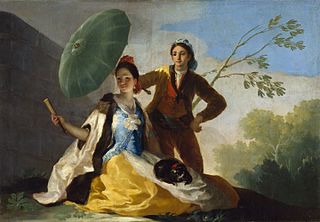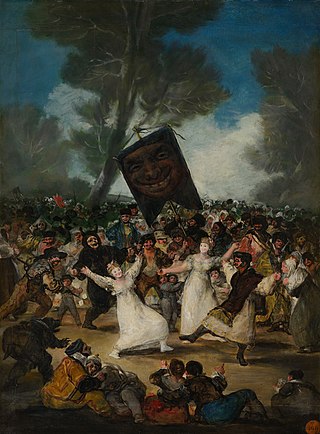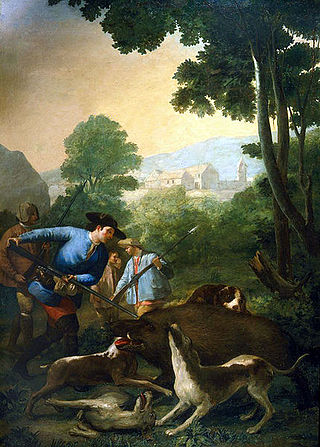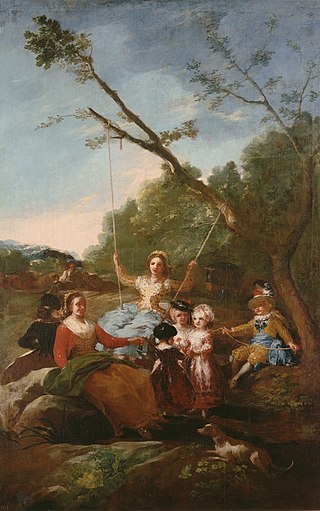
Francisco José de Goya y Lucientes was a Spanish romantic painter and printmaker. He is considered the most important Spanish artist of the late 18th and early 19th centuries. His paintings, drawings, and engravings reflected contemporary historical upheavals and influenced important 19th- and 20th-century painters. Goya is often referred to as the last of the Old Masters and the first of the moderns.
Events from the year 1789 in art.

The Sleep of Reason Produces Monsters or The Dream of Reason Produces Monsters is an aquatint by the Spanish painter and printmaker Francisco Goya. Created between 1797 and 1799 for the Diario de Madrid, it is the 43rd of the 80 aquatints making up the satirical Los caprichos.

The Parasol is one of a cartoon series of oil on linen paintings made by the painter Francisco Goya. This series of paintings was specifically made in order to be transformed into tapestries that would be hung on the walls of the Royal Palace of El Pardo in Madrid, Spain. The tapestries showed serene events in everyday life, which made them a nice addition to the dining room of Prince and Princess of Asturias—the future King Charles IV and Maria Luisa of Parma. The queen called on Goya because she wanted to decorate the dining room with cheerful scenes; The Parasol and the other tapestry paintings were Goya's response to this request. The painting is currently located in the Museo del Prado in Madrid as is another in the series, Blind man's bluff.

The Burial of the Sardine is an oil-on-panel painting by Spanish artist Francisco Goya, usually dated to the 1810s. The title is posthumous, referring to the culminating event, Entierro de la Sardina, of a three-day carnival in Madrid ending on Ash Wednesday. Masked and disguised revellers are seen dancing their way to the banks of the Manzanares, where a ceremonial sardine will be buried. Goya does not illustrate the fish in the painting, nor the large doll made of straw, called a pelele, from which it hung; the centrepiece is the darkly grinning "King of the Carnival".

A Pilgrimage to San Isidro is one of the Black Paintings painted by Francisco de Goya between 1819–23 on the interior walls of the house known as Quinta del Sordo that he purchased in 1819. It probably occupied a wall on the first floor of the house, opposite The Great He-Goat.

The Inquisition Tribunal, also known as The Court of the Inquisition or The Inquisition Scene, is a 46-by-73-centimetre oil-on-panel painting produced by the Spanish artist Francisco Goya between 1812 and 1819. The painting belongs to a series which also includes Bullfight, The Madhouse and A Procession of Flagellants, all reflecting customs which liberals objected to and wished were abandoned, but their reform was opposed by the absolutist (autocratic) policy of Ferdinand VII of Spain.

The Royal Tapestry Factory is a factory making tapestries in Madrid, Spain, which was founded in 1720 and is still in operation.

The Greasy Pole is an oil painting on canvas executed ca. 1786–87 by the Spanish artist Francisco de Goya.

The Boar Hunt is a painting of 1775 by Francisco Goya and the earliest surviving tapestry cartoon by the artist. It depicts men with dogs and boar spears killing a boar.

The Water Bearer is an oil-on-canvas painting by the Spanish artist Francisco de Goya, now in the Museum of Fine Arts in Budapest. The painting's Spanish title "La Aguadora" has also been translated as Young Woman with a Pitcher or the Water Carrier.

The Threshing Floor is an oil sketch by Francisco Goya. He painted it in the 1780s as a small-scale sketch for a tapestry cartoon entitled Summer, part of a set of designs for tapestries for the Royal Palace of El Pardo, specifically the rooms of the Prince of Asturias and his wife Maria Luisa.

Summer or The Threshing Floor is the largest cartoon painted by Francisco de Goya as a tapestry design for Spain's Royal Tapestry Factory. Painted from 1786 to 1787, it was part of his fifth series, dedicated to traditional themes and intended for the heir to the Spanish throne and his wife. The tapestries were to hang in the couple's dining room at the Pardo Palace.

Children in a Chariot is a 1779 painting by Francisco de Goya. It is part of the third series of cartoons he produced for tapestries at the Royal Palace of El Pardo; the tapestry in question was to be positioned over a door. The painting is in the Toledo Museum of Art.

The Drunk Mason is an oil on canvas painted by Francisco de Goya, then reputed painter of tapestries for the royal palaces. It belonged to the fifth series undertaken by Goya, and, like all the pieces that compose it, was painted between 1786 and 1787.

The series of paintings for the alameda of the Dukes of Osuna comprises seven pictures painted by Francisco de Goya between 1786 and 1787. The country estate of the dukes and duchesses, who were the painter's mecenas and friends, was known as El Capricho, and was located on the outskirts of Madrid.

The tapestry cartoons of Francisco de Goya are a group of oil on canvas paintings by Francisco de Goya between 1775 and 1792 as designs for the Royal Tapestry Factory of Santa Barbara near Madrid in Spain. Although they are not the only tapestry cartoons made at the Royal Factory, they are much the best known. Most of them represent bucolic, hunting, rural and popular themes. They strictly adhered to the tastes of King Charles III and the princes Charles of Bourbon and Maria Luisa of Parma, and were supervised by other artists of the factory such as Maella and the Bayeu family. Most are now in the Museo del Prado, having remained in the Spanish Royal collection, although there are some in art galleries in other countries.

The Swing is the title of a tapestry cartoon designed by Francisco de Goya for the bedroom of the Princes of Asturias in the Palace of El Pardo. It is kept in the Museo del Prado.
This page is based on this
Wikipedia article Text is available under the
CC BY-SA 4.0 license; additional terms may apply.
Images, videos and audio are available under their respective licenses.
















